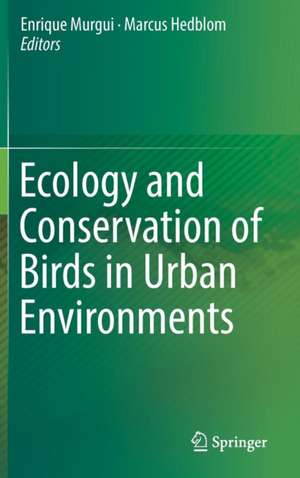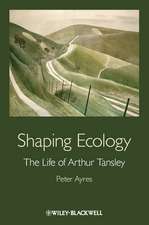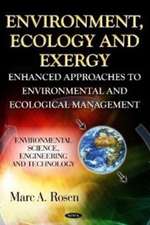Ecology and Conservation of Birds in Urban Environments
Editat de Enrique Murgui, Marcus Hedblomen Limba Engleză Hardback – 17 feb 2017
Birds are among the most conspicuous and fascinating residents of urban neighborhoods and provide urban citizens with everyday wildlife contact all over the world. However, present urbanization trends are rapidly depleting their habitats, and thus knowledge of urban bird ecology is urgently needed if birds are to thrive in cities.
The book is unique in its inclusion of examples from all continents (except Antarctica) in an effort to arrive at a more holistic perspective. Among other issues, the individual chapters address the censusing of birds in urban green spaces; the relationship between bird communities and the structure of urban green spaces; the role of exotic plant species as food sources for urban bird fauna; the influence of artificial light and pollutants on bird fauna; trends in long-term urban bird research, and transdisciplinary studies on bird sounds and their effects on humans. Several chapters investigate how our current knowledge of the ecology of urban bird fauna should be applied in order to achieve better management of urban habitats so as to achieve conservation of species or even increase species diversity. The book also provides a forward-looking summary on potential research directions. As such,it provides a valuable resource for urban ecologists, urban ecology students, landscape architects, city planners, decision makers and anyone with an interest in urban ornithology and bird conservation. Moreover, it provides a comprehensive overview for researchers in the fields of ecology and conservation of urban bird fauna.
| Toate formatele și edițiile | Preț | Express |
|---|---|---|
| Paperback (1) | 1010.48 lei 6-8 săpt. | |
| Springer International Publishing – 13 iul 2018 | 1010.48 lei 6-8 săpt. | |
| Hardback (1) | 1397.82 lei 6-8 săpt. | |
| Springer International Publishing – 17 feb 2017 | 1397.82 lei 6-8 săpt. |
Preț: 1397.82 lei
Preț vechi: 1704.66 lei
-18% Nou
Puncte Express: 2097
Preț estimativ în valută:
267.47€ • 280.01$ • 221.32£
267.47€ • 280.01$ • 221.32£
Carte tipărită la comandă
Livrare economică 05-19 aprilie
Preluare comenzi: 021 569.72.76
Specificații
ISBN-13: 9783319433127
ISBN-10: 3319433121
Pagini: 600
Ilustrații: XIII, 525 p. 82 illus., 28 illus. in color.
Dimensiuni: 155 x 235 x 39 mm
Greutate: 0.93 kg
Ediția:1st ed. 2017
Editura: Springer International Publishing
Colecția Springer
Locul publicării:Cham, Switzerland
ISBN-10: 3319433121
Pagini: 600
Ilustrații: XIII, 525 p. 82 illus., 28 illus. in color.
Dimensiuni: 155 x 235 x 39 mm
Greutate: 0.93 kg
Ediția:1st ed. 2017
Editura: Springer International Publishing
Colecția Springer
Locul publicării:Cham, Switzerland
Cuprins
Preface.- Introduction (Murgui, E. & Hedblom, M.).- Section 1: GENERAL PATTERNS AND PROCESSES.- Global patterns and drivers of urban birds (Aronson, M. et al.).- Birds and urbanization: Spatial and temporal patterns emerging from the southern Neotropics (Bellocq, I.).- The role of landscape scale factors in shaping the composition of urban birds communities (Litteral, J. & Shochat, E.).- Non-indigenous birds and urbanized environments (Sol, D.).- Mechanisms of behavioural changes in urban animals: the role of evolution and plasticity (Miranda, A.C.).- Section 2: METHODOLOGICAL APPROACHES.- Ornithological atlases of towns and cities in Europe (Luniak, M.).- Counting birds in urban areas (van Heezik, Y. & Seddon, P.).- Long-Term Urban Avian Research (Ficino, M. & Magle, S.).- Section 3: URBAN BIRD HABITATS MANAGEMENT.- Management of urban nature and its impact on bird fauna (Heyman, E. & Gunnarsson, B.).- Green infrastructure in urban areas: how does it affect bird populations? (Chiquet, C.).- Social and ecological factors determining the diversity of birds in residential landscapes (Goddard, M. & Leman, S.).- Facilitating Feathered Friends – Improving Avifauna Promotion in Post-construction Urban Planning Procedures (Daniels, G.).- The role of invasive plant species in urban avian conservation (Gleditsch, J.).- Birds and wastelands (Meffert, P.).- Section 4: ANTHROPOGENIC FACTORS.- Pollutants in urbanized areas – direct and indirect effects on bird populations (Kekkonen, J.).- Going wild: Using light-loggers to investigate the effects of light pollution on wild animals (Dominoni, D.).- Bird diversity – panacea for human well-being in cities? (Hedblom, M. & Gunnarsson, B.).- Becoming citizens: avian adaptations to urban life (Macias, C., Suarez, M. & López, I.).- Section 5: URBAN BIRD CONSERVATION.- How to use monitoring data for conservation (Louwe, J.).- Indicators of the effects of the urban green infrastructure on birds (Herrando, S.).- Richness and species of conservation concern in parks of Italian towns (Sorace, A. & Gustin, M.).- Concluding remarks (Hedblom, M. & Murgui, E.).
Recenzii
“This book is an excellent summarization of the research … . This book is both well written and scholarly. It offers a lucid account on urban birds and it will be handy for researchers.” (S.Suresh Ramanan and Lalit Upadhyay, Journal of Threatened Taxa, Vol. 11 (5), 2019)
“This book is a wonderful addition to the current urban bird conservation literature. … this collection of research is valuable both as an overview of avian ecology in an urban setting and as vehicle to present specific research that is of value for future conservation and management efforts. Its global application is to be applauded—the diversity of ecosystems and management methods presented make it a useful review of this topic.” (Carol A. Pollio, The Quarterly Reviewof Biology, Vol. 93 (1), March, 2018)
“The text comprises thought-provoking parts that introduce the theme that birds in cities are important ecological entities, address the influence of urbanization and adaptation on populations, offer aspects of research and methodology, discuss anthropogenic factors … and provide case studies pertaining to urban habitats. Summing Up: Recommended. Lower-division undergraduates and above; faculty and professionals.” (M. Gochfeld, Choice, Vol. 55 (1), September, 2017)
“This new publication provides a timely review of the vast amount of work to have been done within the last two decades, something that should stimulate and direct future research efforts. ... this is an important publication and one which brings to the fore a wide range of research from a broader suite of countries than seen before. … The editors and contributors are to be congratulated.” (Mike Toms, Bird Study, April, 2017)“This book is a wonderful addition to the current urban bird conservation literature. … this collection of research is valuable both as an overview of avian ecology in an urban setting and as vehicle to present specific research that is of value for future conservation and management efforts. Its global application is to be applauded—the diversity of ecosystems and management methods presented make it a useful review of this topic.” (Carol A. Pollio, The Quarterly Reviewof Biology, Vol. 93 (1), March, 2018)
“The text comprises thought-provoking parts that introduce the theme that birds in cities are important ecological entities, address the influence of urbanization and adaptation on populations, offer aspects of research and methodology, discuss anthropogenic factors … and provide case studies pertaining to urban habitats. Summing Up: Recommended. Lower-division undergraduates and above; faculty and professionals.” (M. Gochfeld, Choice, Vol. 55 (1), September, 2017)
Notă biografică
Enrique Murgui
After he graduated as biologist in 1992 Enrique has been involved in every sort of ornithological projects from censusing bird fauna in uplands to collaborate in several NGOs, and giving professional assistance to different firms. In 2006 he received his PhD dealing with the influence of urban landscape structure on bird fauna. Since then he has been involved in a long-term research on how urbanization affect bird fauna across time, and in other research and professional projects ranging from an investigation on peri-urban farmland bird communities to monitoring bird fauna in windfarms.
Marcus Hedblom
Marcus received his PhD in 2007 concerning birds and butterflies in urban and peri-urban habitats. He has since then worked as a nature conservation strategist in the fourth largest city in Sweden (Uppsala), made a post-doc at Gothenburg University and worked as a project leader at the national monitoring program for biodiversity (NILS) at the Swedish University of Agricultural Sciences (SLU). He is presently involved in numerous transdisciplinary research projects concerning urban ecosystem services and leader of a research group studying human stress reduction from natural sounds in cities at SLU. Marcus is an associate editor of the Journal Urban Ecosystems and founder of the Swedish Think tank Green City.
After he graduated as biologist in 1992 Enrique has been involved in every sort of ornithological projects from censusing bird fauna in uplands to collaborate in several NGOs, and giving professional assistance to different firms. In 2006 he received his PhD dealing with the influence of urban landscape structure on bird fauna. Since then he has been involved in a long-term research on how urbanization affect bird fauna across time, and in other research and professional projects ranging from an investigation on peri-urban farmland bird communities to monitoring bird fauna in windfarms.
Marcus Hedblom
Marcus received his PhD in 2007 concerning birds and butterflies in urban and peri-urban habitats. He has since then worked as a nature conservation strategist in the fourth largest city in Sweden (Uppsala), made a post-doc at Gothenburg University and worked as a project leader at the national monitoring program for biodiversity (NILS) at the Swedish University of Agricultural Sciences (SLU). He is presently involved in numerous transdisciplinary research projects concerning urban ecosystem services and leader of a research group studying human stress reduction from natural sounds in cities at SLU. Marcus is an associate editor of the Journal Urban Ecosystems and founder of the Swedish Think tank Green City.
Textul de pe ultima copertă
This book provides syntheses of ecological theories and overarching patterns of urban bird ecology that have only recently become available. The numerous habitats represented in this book ranges from rows of trees in wooded alleys, to wastelands and remnants of natural habitats encapsulated in the urban matrix. Authored by leading scientists in this emergent field, the chapters explore how the characteristics of the habitat in urban environments influence bird communities and populations at multiple levels of ecological organization and at different spatial and temporal scales, and how this information should be incorporated in urban planning to achieve an effective conservation of bird fauna in urban environments.
Birds are among the most conspicuous and fascinating residents of urban neighborhoods and provide urban citizens with everyday wildlife contact all over the world. However, present urbanization trends are rapidly depleting their habitats, and thus knowledge of urban bird ecology is urgently needed if birds are to thrive in cities.
The book is unique in its inclusion of examples from all continents (except Antarctica) in an effort to arrive at a more holistic perspective. Among other issues, the individual chapters address the censusing of birds in urban green spaces; the relationship between bird communities and the structure of urban green spaces; the role of exotic plant species as food sources for urban bird fauna; the influence of artificial light and pollutants on bird fauna; trends in long-term urban bird research, and transdisciplinary studies on bird sounds and their effects on humans. Several chapters investigate how our current knowledge of the ecology of urban bird fauna should be applied in order to achieve better management of urban habitats so as to achieve conservation of species or even increase species diversity. The book also provides a forward-looking summary on potential research directions. As such,it provides a valuable resource for urban ecologists, urban ecology students, landscape architects, city planners, decision makers and anyone with an interest in urban ornithology and bird conservation. Moreover, it provides a comprehensive overview for researchers in the fields of ecology and conservation of urban bird fauna.
Birds are among the most conspicuous and fascinating residents of urban neighborhoods and provide urban citizens with everyday wildlife contact all over the world. However, present urbanization trends are rapidly depleting their habitats, and thus knowledge of urban bird ecology is urgently needed if birds are to thrive in cities.
The book is unique in its inclusion of examples from all continents (except Antarctica) in an effort to arrive at a more holistic perspective. Among other issues, the individual chapters address the censusing of birds in urban green spaces; the relationship between bird communities and the structure of urban green spaces; the role of exotic plant species as food sources for urban bird fauna; the influence of artificial light and pollutants on bird fauna; trends in long-term urban bird research, and transdisciplinary studies on bird sounds and their effects on humans. Several chapters investigate how our current knowledge of the ecology of urban bird fauna should be applied in order to achieve better management of urban habitats so as to achieve conservation of species or even increase species diversity. The book also provides a forward-looking summary on potential research directions. As such,it provides a valuable resource for urban ecologists, urban ecology students, landscape architects, city planners, decision makers and anyone with an interest in urban ornithology and bird conservation. Moreover, it provides a comprehensive overview for researchers in the fields of ecology and conservation of urban bird fauna.
Caracteristici
Summarizes the current research on the interplay between urban environments and bird fauna Provides a conservation-based approach, paying special attention to issues like bird monitoring and managing of bird populations, and the incardination of the design and management of urban green spaces in urban planning policies Includes examples coming from different parts of the world in an effort to obtain a thorough perspective














